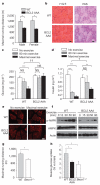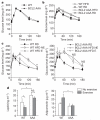Exercise-induced BCL2-regulated autophagy is required for muscle glucose homeostasis
- PMID: 22258505
- PMCID: PMC3518436
- DOI: 10.1038/nature10758
Exercise-induced BCL2-regulated autophagy is required for muscle glucose homeostasis
Erratum in
- Nature. 2013 Nov 7:503(7474):146
Abstract
Exercise has beneficial effects on human health, including protection against metabolic disorders such as diabetes. However, the cellular mechanisms underlying these effects are incompletely understood. The lysosomal degradation pathway, autophagy, is an intracellular recycling system that functions during basal conditions in organelle and protein quality control. During stress, increased levels of autophagy permit cells to adapt to changing nutritional and energy demands through protein catabolism. Moreover, in animal models, autophagy protects against diseases such as cancer, neurodegenerative disorders, infections, inflammatory diseases, ageing and insulin resistance. Here we show that acute exercise induces autophagy in skeletal and cardiac muscle of fed mice. To investigate the role of exercise-mediated autophagy in vivo, we generated mutant mice that show normal levels of basal autophagy but are deficient in stimulus (exercise- or starvation)-induced autophagy. These mice (termed BCL2 AAA mice) contain knock-in mutations in BCL2 phosphorylation sites (Thr69Ala, Ser70Ala and Ser84Ala) that prevent stimulus-induced disruption of the BCL2-beclin-1 complex and autophagy activation. BCL2 AAA mice show decreased endurance and altered glucose metabolism during acute exercise, as well as impaired chronic exercise-mediated protection against high-fat-diet-induced glucose intolerance. Thus, exercise induces autophagy, BCL2 is a crucial regulator of exercise- (and starvation)-induced autophagy in vivo, and autophagy induction may contribute to the beneficial metabolic effects of exercise.
Figures




Comment in
-
Metabolism: Keeping fit with autophagy.Nat Rev Mol Cell Biol. 2012 Feb 1;13(3):136. doi: 10.1038/nrm3287. Nat Rev Mol Cell Biol. 2012. PMID: 22293615 No abstract available.
-
Autophagy works out.Cell Metab. 2012 Mar 7;15(3):273-4. doi: 10.1016/j.cmet.2012.02.008. Cell Metab. 2012. PMID: 22405064 Free PMC article.
References
-
- Kuma A, Mizushima N. Physiological role of autophagy as an intracellular recycling system: with an emphasis on nutrient metabolism. Semin. Cell Dev. Biol. 2010;21:683–690. - PubMed
Publication types
MeSH terms
Substances
Grants and funding
- R01 AI084887/AI/NIAID NIH HHS/United States
- P01 DK088761/DK/NIDDK NIH HHS/United States
- RCI DK086629/DK/NIDDK NIH HHS/United States
- HHMI/Howard Hughes Medical Institute/United States
- 1P01 DK0887761/DK/NIDDK NIH HHS/United States
- P30 CA142543/CA/NCI NIH HHS/United States
- R0I HL090842/HL/NHLBI NIH HHS/United States
- R01 CA109618/CA/NCI NIH HHS/United States
- R0I AI084887/AI/NIAID NIH HHS/United States
- R01 CA112023/CA/NCI NIH HHS/United States
- R0I HL080244/HL/NHLBI NIH HHS/United States
- RC1 DK086629/DK/NIDDK NIH HHS/United States
- R01 HL090842/HL/NHLBI NIH HHS/United States
- R01 DK055758/DK/NIDDK NIH HHS/United States
LinkOut - more resources
Full Text Sources
Other Literature Sources
Molecular Biology Databases
Research Materials

